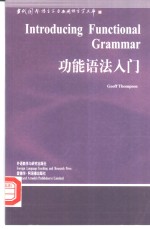

功能语法入门PDF电子书下载
- 电子书积分:11 积分如何计算积分?
- 作 者:(英)Geoff Thompson著;黄国文导读
- 出 版 社:北京:外语教学与研究出版社
- 出版年份:2000
- ISBN:7560019870
- 页数:267 页
1.The purposes of linguistic analysis 1
1.1 Starting-points 1
1.1.1 Goingin through form 2
1.1.2 Going in through meaning 6
1.2 Language,context and function:a preliminary exploration 10
Exercise 11
2.Identifying clauses and clause constituents 13
2.1 Breaking up the sentence and labelling the parts 13
2.1.1 Recognising constituents 13
2.1.2 Structural and functional labels 17
2.2 Ranks 20
Exercise 24
3.An overview of Functional Grammar 26
3.1 Three kinds of meaning 26
3.1.1 The three metafunctions 28
3.1.2 Three kinds of function in the clause 30
3.1.3 Three kinds of structure in the clause 32
3.1.4 Bringing it all together 33
3.1.5 A fourth metafunction 35
3.2 Register and genre 35
4.Interaction in the clause:the interpersonal metafunction 38
4.1 Introduction 38
4.2 Roles of addressers and audience 39
4.3 Mood 41
4.3.1 The structure of the Mood 41
4.3.2 Identifying Subject and Finite 42
4.3.3 Meanings of Subject and Finite 44
4.3.4 Mood in non-declarative clauses 46
4.3.5 The Residue 50
4.3.6 Modal Adjuncts 52
4.4.1 Modality and polarity 56
4.4 Modality 56
4.4.2 Types of modality 57
4.4.3 Modal commitment 59
4.4.4 Modal responsibility 60
4.4.5 Modality in text 63
4.5 Evaluation 65
4.6 Interaction and negotiation 67
4.7 Interaction in text 70
Exercises 73
5.Representing the world:the experiential metafunction 76
5.1 Introduction 76
5.2 Transitivity 78
5.2.1 Material processes 79
5.2.2 Mental processes 82
5.2.3 Relational processes 86
5.2.4 Other types of process 96
5.2.5 Other participant roles 102
5.2.6 Circumstances 104
5.2.7 Transitivity in text 107
5.3 Ergativity 112
Exercises 115
6.Organising the message:the textual metafunction:Theme 117
6.1 Introduction 117
6.2 Theme 118
6.3 Identifying Theme 119
6.3.1 Theme in declarative clauses 119
6.3.2 Theme in non-declarative clauses 122
6.4 Thematising structures 125
6.4.1 Thematic equatives 125
6.4.2 Predicated Theme 127
6.4.3 Thematised comment 129
6.4.5 Passive clauses and Theme 130
6.4.4 Preposed Theme 130
6.5 Theme in clause complexes 131
6.6 Multiple Theme 133
6.6.1 Conjunctions in Theme 134
6.6.2 Conjunctive and modal Adjuncts in Theme 134
6.6.3 Textual,interpersonal and experiential elements in Theme 136
6.6.4 Interrogatives as multiple Themes 137
6.7 Some problems in Theme analysis 138
6.7.1 Existential'there'as Theme 138
6.7.2 Theme in reported clauses 139
6.7.3 Interpolations in Theme 139
6.7.4 Preposed attributives 140
6.8 Theme in text 141
Exercises 144
7.1 Cohesion and coherence 147
7.Organising the message:the textual metafunction:cohesion 147
7.2 Reference and ellipsis 148
7.2.1 Reference 148
7.2.2 Ellipsis 152
7.3 Conjunction 156
7.4 Cohesion in text 158
Exercise 161
8.Grammatical metaphor 163
8.1 Introduction 163
8.2 Experiential and logical metaphors 166
8.3 Interpersonal metaphors 172
8.4 Textual metaphor 176
8.5 A cautionary note 176
Exercises 177
9.1.1 Nominal groups 179
9.Groups and phrases 179
9.1 Groups 179
9.1.2 Verbal groups 185
9.1.3 Other types of group 188
9.2 Prepositional phrases 189
9.3 Group complexes 190
Exercises 192
10.Clauses in combination 194
10.1 Units of analysis 194
10.2 Types of relations between clauses 196
10.2.1 Logical dependency relations 196
10.2.2 Logico-semantic relations 200
10.3 Expansion 201
10.3.1 Elaborating 201
10.3.2 Extending 203
10.3.3 Enhancing 204
10.4 Projection 206
10.4.1 Quotes and reports 206
10.4.2 Facts 209
10.4.3 Projection in text 210
Exercises 211
11.Implications and applications of Functional Grammar 214
11.1 Three-dimensional analysis of texts 214
11.2 A summary review of Functional Grammar 220
11.3 Using Functional Grammar 222
11.4 Closing 224
Answers to exercises 225
Further Reading 250
References 254
Index 257
文库索引 263
- 《HTML5从入门到精通 第3版》(中国)明日科技 2019
- 《少儿电子琴入门教程 双色图解版》灌木文化 2019
- 《培生高级英语语法 练习册》培生教育 2019
- 《区块链DAPP开发入门、代码实现、场景应用》李万胜著 2019
- 《Python3从入门到实战》董洪伟 2019
- 《功能涂料》刘仁主编 2018
- 《小提琴入门新教程 第3册》王中男著 2018
- 《海洋功能食品》王卉 2019
- 《小提琴入门新教程 第2册》王中男编著 2017
- 《功能食品 第2版》孟宪军 2017
- 《中风偏瘫 脑萎缩 痴呆 最新治疗原则与方法》孙作东著 2004
- 《水面舰艇编队作战运筹分析》谭安胜著 2009
- 《王蒙文集 新版 35 评点《红楼梦》 上》王蒙著 2020
- 《TED说话的力量 世界优秀演讲者的口才秘诀》(坦桑)阿卡什·P.卡里亚著 2019
- 《燕堂夜话》蒋忠和著 2019
- 《经久》静水边著 2019
- 《魔法销售台词》(美)埃尔默·惠勒著 2019
- 《微表情密码》(波)卡西亚·韦佐夫斯基,(波)帕特里克·韦佐夫斯基著 2019
- 《看书琐记与作文秘诀》鲁迅著 2019
- 《酒国》莫言著 2019
